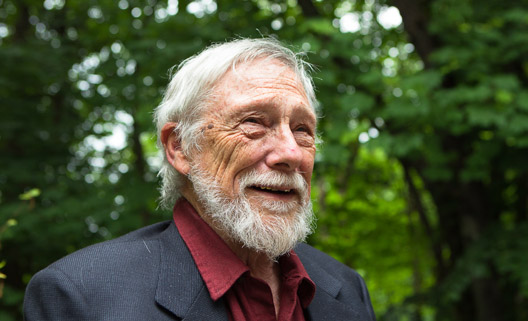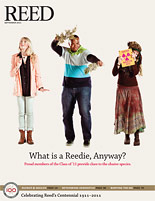
IRIS login | Reed College home Volume 90, No. 3: September 2011
Web Special
Force of Nature

Photo by Stu Mullengerg
Walking Through the Canyon with Gary Snyder ’51
By Bill Donahue
The poet Gary Snyder ’51 was once called the “Thoreau of the Beat generation.” When he was just 17, long before he won a Pulitzer prize for “Turtle Island,” he camped overnight on the frigid summit of Mount Hood. Later, he dragged Jack Kerouac, a hiking neophyte, up 12,279-foot Matterhorn Peak in Yosemite, and spent a decade in Japan. As he studied Buddhism there, he often scrambled amid cragged peaks, ritually chanting and blowing on conch shells.
On a recent June morning, he embarked on a more modest mission, padding downhill from Eliot Hall in a blue blazer, tan khakis, and a a pair of immaculate tan leather dress shoes. He cut into the woods, over a bark chip trail, to the muddy banks of Reed Lake, where he sat down on a bench, reminiscing. At Reed, Snyder wrote a journalism class paper, now lost to the winds, about the six underground springs that bubble up out of the ground to form the lake and the creek that flows west from it. He interviewed a Reed groundskeeper about the creek’s flow rate and the geology of the canyon surrounding it. “His information was good,” Snyder said, “and he told me no one had ever asked him about Crystal Springs.”
Gary Snyder gives the keynote address at Centennial Fanfayre.
Now, Snyder was alighting lakeside to reconnect with the Canyon, which has radically changed since his day. “They had an Army Corps of Engineers approach to management back then,” he said. “There weren’t so many branches sitting in the water. We’d have ‘cleanups’ where the students would come down and pull everything out. There was a dam over there”—he pointed—“and one year, I remember, the lake froze and we ice skated down here. This is a little island of relative wilderness. Ten thousand years from now, when the city is gone and the trees have taken over again, it will still be here.”
Snyder stopped, then cocked his arm to look at his large, stylish dial hand watch. He was on campus to serve as the keynote speaker at Centennial Reunions. The college’s literature was warmly celebrating him as the “grandfather of the tribe,” but there was something cool and disciplined—indeed almost fastidious—about him. He has been a diligent Buddhist for over 50 years, and his poems sing with crisp distillations. Consider:
Stone-flake and salmon.
The pure, sweet, straight-splitting with a ping
Red cedar of the thick coast valleys.
“This is the landscape of my childhood,” he continued. “I grew up on a farm north of Seattle, and I’ve known the plants of the Pacific Northwest since I was a little tiny kid: salmonberries, salal, Oregon grape, vine maple, western red cedar. On our land, we had these extraordinary large stumps, the remnants of old growth forest, and I think I was touched by the ghosts of those trees.”
When Snyder was 12, his parents divorced. He moved to Portland with his mother and soon became fascinated with Native American culture. “In eighth grade, on my walk to Ainsworth School,” he said, “there was a statue of Sacagawea. I thought she was beautiful.” He kept thinking of Indians as a teen, hiking Mount St. Helens, Mount Adams and Mount Baker, and by the time he matriculated at Reed, he already felt conflicted, he said, about “being a member of a society that was destroying its own ground.” He majored in anthropology and wrote his thesis about a Haida Indian myth, “He Who Hunted Birds.”
Weekends, he headed to the mountains. “You have to pay attention to the nature around you,” he says. “Nature is happening everywhere, always, and it’s almost a matter of etiquette for you to go to out and say hello to the plants and—”
Just now, a pair of mallard ducks flew by, whirring under the Canyon Bridge, their wings fluttering as they braked and swooped down to the water. “Wow!” said Synder. “Will you look at that? Earlier, I saw a kingfisher and a great blue heron.”
“If we walk down the path about five minutes,” I said, “we could see if there’s more wildlife at the source of the springs.”
“Look,” Snyder rejoindered, “you have got to get this straight—I don’t have much time.” His manner was not abrasive, just momentarily firm, and he segued gently, noting that over the coming weekend he would be venturing into Portland’s Washington Park, along with his son and 13-year-old granddaughter. “That Sacagawea statue was moved there, a long time ago,” he said, before adding slyly, “Almost nobody knows where it is, but I have the GPS coordinates.”
He began to rise from the bench, but then he paused, deciding to make one final and cosmic point. “You know,” he said in genial tones, “it’s a shame that the Europeans didn’t come to this continent 200 or 300 years earlier. If they had, the Native Americans would have had plenty of time to learn how to use firearms, and they never would have been defeated. The American West would still belong to the Indians.”
He checked his watch again. “Time to go,” he said. And then he padded uphill, out of the canyon. When he got to the library a few minutes later, his dress shoes were still clean.


LATEST COMMENTS
steve-jobs-1976 I knew Steve Jobs when he was on the second floor of Quincy. (Fall...
Utnapishtim - 2 weeks ago
Prof. Mason Drukman [political science 1964–70] This is gold, pure gold. God bless, Prof. Drukman.
puredog - 1 month ago
virginia-davis-1965 Such a good friend & compatriot in the day of Satyricon...
czarchasm - 4 months ago
John Peara Baba 1990 John died of a broken heart from losing his mom and then his...
kodachrome - 7 months ago
Carol Sawyer 1962 Who wrote this obit? I'm writing something about Carol Sawyer...
MsLaurie Pepper - 8 months ago
William W. Wissman MAT 1969 ...and THREE sisters. Sabra, the oldest, Mary, the middle, and...
riclf - 10 months ago